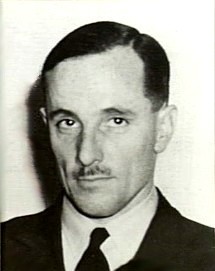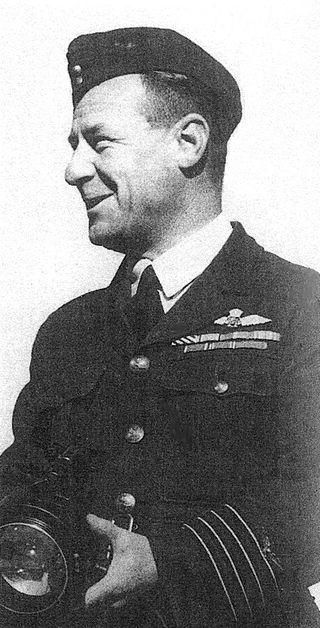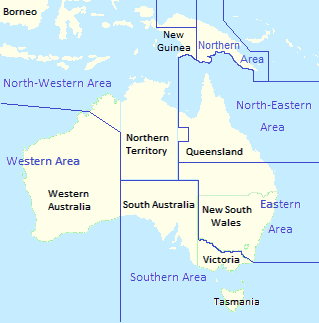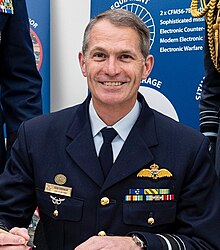
Air Marshal Sir Richard Williams,, is widely regarded as the "father" of the Royal Australian Air Force (RAAF). He was the first military pilot trained in Australia, and went on to command Australian and British fighter units in World War I. A proponent for air power independent of other branches of the armed services, Williams played a leading role in the establishment of the RAAF and became its first Chief of the Air Staff (CAS) in 1922. He served as CAS for thirteen years over three terms, longer than any other officer.

Air Chief Marshal Sir Frederick Rudolph William Scherger, was a senior commander in the Royal Australian Air Force (RAAF). He served as Chief of the Air Staff, the RAAF's highest-ranking position, from 1957 until 1961, and as Chairman of the Chiefs of Staff Committee, forerunner of the role of Australia's Chief of the Defence Force, from 1961 until 1966. He was the first RAAF officer to hold the rank of air chief marshal.

The "Morotai Mutiny" was an incident in April 1945 involving members of the Australian First Tactical Air Force based on the island of Morotai, in the Dutch East Indies. Eight senior pilots, including Australia's leading flying ace, Group Captain Clive Caldwell, tendered their resignations to protest what they perceived as the relegation of Royal Australian Air Force (RAAF) fighter squadrons to strategically unimportant ground attack missions against Japanese positions that had been bypassed in the Allies' "island-hopping" campaign. A government investigation vindicated the "mutineers", and three high-ranking officers at First Tactical Air Force Headquarters, including the commander, Air Commodore Harry Cobby, the Australian Flying Corps' top-scoring ace in World War I, were relieved of their posts.

Air Chief Marshal Sir Neville Patrick McNamara, was a senior commander of the Royal Australian Air Force (RAAF). He served as Chief of the Air Staff (CAS), the RAAF's highest-ranking position, from 1979 until 1982, and as Chief of the Defence Force Staff (CDFS), Australia's top military role at the time, from 1982 until 1984. He was the second RAAF officer to hold the rank of air chief marshal.

Air Marshal Sir George Jones, was a senior commander in the Royal Australian Air Force (RAAF). He rose from private soldier in World War I to air marshal in 1948, and served as Chief of the Air Staff from 1942 to 1952, the longest continuous tenure of any RAAF chief. Jones was a surprise appointee to the Air Force's top role, and his achievements in the position were coloured by a divisive relationship during World War II with his nominal subordinate, the head of RAAF Command, Air Vice-Marshal William Bostock.

Air Vice Marshal William Dowling Bostock, was a senior commander in the Royal Australian Air Force (RAAF). During World War II he led RAAF Command, the Air Force's main operational formation, with responsibility for the defence of Australia and air offensives against Japanese targets in the South West Pacific Area. His achievements in the role earned him the Distinguished Service Order and the American Medal of Freedom. General Douglas MacArthur described him as "one of the world's most successful airmen".

Air Vice Marshal Stanley James (Jimmy) Goble, CBE, DSO, DSC was a senior commander in the Royal Australian Air Force (RAAF). He served three terms as Chief of the Air Staff, alternating with Wing Commander Richard Williams. Goble came to national attention in 1924 when he and fellow RAAF pilot Ivor McIntyre became the first men to circumnavigate Australia by air, journeying 8,450 miles (13,600 km) in a single-engined floatplane.

Air Vice-Marshal William Hopton Anderson, was a senior commander in the Royal Australian Air Force (RAAF). He flew with the Australian Flying Corps in World War I, earning the Distinguished Flying Cross and the Belgian Croix de guerre for his combat service with No. 3 Squadron on the Western Front in 1917. The following year he took command of No. 7 (Training) Squadron and, later, No. 3 Squadron. Anderson led the Australian Air Corps during its brief existence in 1920–21, before joining the fledgling RAAF. The service's third most-senior officer, he primarily held posts on the Australian Air Board in the inter-war years. He was appointed a Commander of the Order of the British Empire in 1934, and promoted to air commodore in 1938.

Air Marshal Sir Valston Eldridge Hancock, was a senior commander in the Royal Australian Air Force (RAAF). He served as Chief of the Air Staff from 1961 to 1965. A graduate of the Royal Military College, Duntroon, Hancock transferred from the Army to the RAAF in 1929 and qualified as a pilot. His administrative training at Duntroon saw him mainly occupy staff posts, including Deputy Director of Operations and Intelligence at RAAF Headquarters from 1931 to 1935, and Director of Works and Buildings from 1937 to 1939. During the early years of World War II, he commanded No. 1 Bombing and Gunnery School, and held senior planning and administrative positions. He eventually saw combat in the Aitape–Wewak campaign of the Pacific War during 1945. Flying Bristol Beaufort light bombers, he led first No. 100 Squadron, and later No. 71 Wing. His actions earned him the Distinguished Flying Cross.

Air Marshal Sir John Patrick Joseph McCauley, KBE, CB was a senior commander in the Royal Australian Air Force (RAAF). He served as Chief of the Air Staff from 1954 to 1957. A Duntroon graduate, McCauley spent four years in the Australian Military Forces before transferring to the RAAF in 1924. He was Director of Training from 1936 to 1938, and commanded engineering and flying training schools for the first eighteen months of World War II. Having been promoted to group captain in 1940, he was posted to Singapore in June 1941 to take charge of all RAAF units defending the area. He earned praise for his efforts in attacking invading Japanese forces before the fall of Singapore, and for his dedication in evacuating his men. After serving as Deputy Chief of the Air Staff in 1942–44, he was appointed to a senior operational role with the Royal Air Force's 2nd Tactical Air Force in Europe, where he saw out the rest of the war.

Air Marshal Sir Alister Murray Murdoch, was a senior commander in the Royal Australian Air Force (RAAF). He served as Chief of the Air Staff (CAS) from 1965 to 1969. Joining the Air Force in 1930, Murdoch trained as a seaplane pilot and participated in an Antarctic rescue mission for lost explorers in 1935. During World War II, he commanded No. 221 Squadron RAF in Europe and the Middle East, and later occupied senior positions on the staff of RAAF formations in the South West Pacific. His post-war appointments included Commandant of RAAF College from 1952 to 1953, Air Officer Commanding (AOC) Training Command from 1953 to 1955, Deputy Chief of the Air Staff from 1958 to 1959, and AOC Operational Command from 1962 to 1965.

Air Vice-Marshal Joseph Eric Hewitt, was a senior commander in the Royal Australian Air Force (RAAF). A Royal Australian Navy officer who transferred permanently to the Air Force in 1928, he commanded No. 101 Flight in the early 1930s, and No. 104 (Bomber) Squadron RAF on exchange in Britain shortly before World War II. Hewitt was appointed the RAAF's Assistant Chief of the Air Staff in 1941. The following year he was posted to Allied Air Forces Headquarters, South West Pacific Area, as Director of Intelligence. In 1943, he took command of No. 9 Operational Group, the RAAF's main mobile strike force, but was controversially sacked by the Chief of the Air Staff, Air Vice Marshal George Jones, less than a year later over alleged morale and disciplinary issues.

Air Commodore Hippolyte Ferdinand (Frank) De La Rue, CBE, DFC was a senior commander in the Royal Australian Air Force (RAAF). Joining the Mercantile Marine as a youth, he became a pilot in Britain's Royal Naval Air Service during World War I. In 1918, he was given command of No. 223 Squadron in the newly formed Royal Air Force. The following year he took charge of No. 270 Squadron RAF in Egypt. Returning to Australia, De La Rue joined the short-lived Australian Air Corps in 1920, and became a founding member of the RAAF in March 1921. Specialising in maritime aviation, he led seaplane formations based at Point Cook, Victoria, during the 1920s and early 1930s.
Air Marshal Raymond George (Ray) Funnell, is a retired senior commander of the Royal Australian Air Force (RAAF). He served as Chief of the Air Staff (CAS) from 1987 until 1992. A graduate of RAAF College, he began his career flying CAC Sabre jet fighters in Australia and South East Asia in the 1950s and 1960s. From 1972 to 1975 he commanded No. 6 Squadron, during which time the General Dynamics F-111C swing-wing bomber entered Australian service. He held senior staff posts in the early 1980s. In 1986, he was promoted to air marshal and became the inaugural Vice Chief of the Defence Force. Appointed CAS in July 1987, Funnell was closely involved in the development and dissemination of air power doctrine. He retired from the RAAF in October 1992 following his term as CAS, and was founding Principal of the Australian College of Defence and Strategic Studies from 1994 to 1998. Since then he has served on various Federal Government committees on immigration and detention.

Air Vice Marshal Allan Leslie Walters, CB, CBE, AFC was a senior commander in the Royal Australian Air Force (RAAF). Born in Victoria and raised in Western Australia, he graduated from the Royal Military College, Duntroon, before transferring to the RAAF in 1928. He was one of the service's leading flying instructors and aerobatic pilots between the wars, and was appointed to his first squadron command in 1937. Over the course of World War II, Walters led No. 1 Squadron in Singapore, No. 1 (Fighter) Wing in Darwin, Northern Territory, No. 72 Wing in Dutch New Guinea, and Northern Command in Papua New Guinea. He was decorated with the Air Force Cross in 1941 for his work with No. 1 Squadron, and mentioned in despatches in 1944 for his service with No. 72 Wing.

RAAF Command was the main operational arm of the Royal Australian Air Force (RAAF) during World War II. The command was formed in September 1942 and by April 1943 comprised 27 squadrons, including units from the Netherlands, the United Kingdom and the United States, as well as Australia. Coming under the operational authority of Allied Air Forces Headquarters in the South West Pacific Area, RAAF Command exercised control of its units through geographically based area commands in Australia and, later, New Guinea, as well as large mobile formations including the Australian First Tactical Air Force. The command reached a strength of 41 squadrons in October 1944. From the time of its establishment, until its disbandment in September 1945, it was led by Air Vice Marshal Bill Bostock.

Air Vice Marshal William Lloyd Hely, CB, CBE, AFC was a senior commander in the Royal Australian Air Force (RAAF). He graduated from the Royal Military College, Duntroon, in 1930 before transferring to the RAAF as a cadet pilot. Hely came to public attention in 1936–37, first when he crashed on a survey flight in the Northern Territory, and later when he undertook two successful missions to locate missing aircraft in the same vicinity. His rescue efforts earned him the Air Force Cross. After occupying staff positions during the early years of World War II, Hely was appointed Officer Commanding No. 72 Wing in Dutch New Guinea in May 1944. Later that year he formed No. 84 Wing, commanding it during the Bougainville campaign until the end of the Pacific War.

Area commands were the major operational and administrative formations of the Royal Australian Air Force (RAAF) between 1940 and 1954. Established in response to the outbreak of World War II, they underpinned the Air Force's geographically based command-and-control system for the duration of the conflict and into the early years of the Cold War, until being superseded by a functional control system made up of Home, Training, and Maintenance Commands.

North-Western Area Command was one of several geographically based commands raised by the Royal Australian Air Force (RAAF) during World War II. Its wartime sphere of operations included the Northern Territory, adjacent portions of Queensland and Western Australia, and the Dutch East Indies. The command was formed in January 1942, following the outbreak of the Pacific War, from the western part of Northern Area Command, which had covered all of northern Australia and Papua. Headquartered at Darwin, North-Western Area Command was initially responsible for air defence, aerial reconnaissance and protection of the sea lanes within its boundaries.

The Air Board, also known as the Administrative Air Board, or the Air Board of Administration, was the controlling body of the Royal Australian Air Force (RAAF) from 1921 to 1976. It was composed of senior RAAF officers as well as some civilian members, and chaired by the Chief of the Air Staff (CAS). The CAS was the operational head of the Air Force, and the other board members were responsible for specific areas of the service such as personnel, supply, engineering, and finance. Originally based in Melbourne, the board relocated to Canberra in 1961.






















